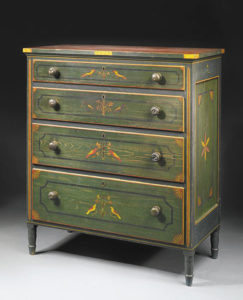 By Anne Gilbert
By Anne Gilbert For centuries lavishly decorated furniture was trendy, and pricey. These days as auction prices prove, the fake and repro gilt and ormolu 18th century pieces languish. Has their time in history passed? Should you buy now, hoping it will make a comeback in your lifetime?
Ancient furniture may not have been comfortable but it was certainly easy on the eyes, at least for royalty, more for comfort than glitz. The furniture of ancient Rome was made from exotic woods and accented with ivory, tortoiseshell and metals. Oriental furniture was usually made of rosewood that was carved in various ways. Lacquer and polychrome paint were used to enrich Chinese furniture. The Japanese combined lacquer with mother-of-pearl inlays and often painted with gold or silver. Some of the most elegant furniture was made in India and the Islamic countries from the 14th century on.
CLUES: Furniture as we know it was created in Europe around the 13th century. It was embellished with gothic motifs and heavy carving. Small, decorative pieces were being made in 16th century Italy. However, it was the armorers, not the woodworkers who created them using inlays of marble and semi-precious stones. By the late 17th century, cabinet-making came into its own in Italy with Baroque designs. The wealthy and royalty commissioned cabinetmakers to create elaborate pieces. Veneering was used, often of ivory, silver and tortoiseshell.
During the same period the Dutch or Low Country became masters of parquetry patterns and floral parquetry. A popular veneer was ebony.
In Spain and Portugal at that time craftsmen made inlays that were delicate abstract geometric or flower-style geometric motif inlays. Decorative sprung-iron brackets trimmed table legs and aprons. German furniture was enriched with intarsia work in varied color woods and often complex scenes. Another German specialty was pietre dure, using semi-precious stones.
 The most elaborate techniques were used in France by the early 18th century. They included the use of engraved brass, tortoiseshell and ebony parquetry. Gilt bronze in many designs decorated every type of furniture. The furniture designed for royalty used such exotic veneers as mother-of-pearl combined with gilt and silvered bronze mounts. Veneering was at its finest with various woods. Imitation Wedgwood jasperware plaques were popular inlays.
The most elaborate techniques were used in France by the early 18th century. They included the use of engraved brass, tortoiseshell and ebony parquetry. Gilt bronze in many designs decorated every type of furniture. The furniture designed for royalty used such exotic veneers as mother-of-pearl combined with gilt and silvered bronze mounts. Veneering was at its finest with various woods. Imitation Wedgwood jasperware plaques were popular inlays. In England in the 17th century Japanned furniture was in fashion, elaborately carved decorations of solid mahogany were applied in the 18th century and various wood veneers were used. However, it is the Thomas Chippendale influence that is most closely associated with English furniture of this period. His Chinese and Gothic influenced carving on the backs of chairs, other furniture and decorative accessories are most familiar. The furniture that has survived Pilgrim century America is usually cupboards and chests. They are trimmed with incised carving and applied, heavily carved wood trim or painted motifs. Painted 18th and 19th century American decorated pieces are collectible if you can find and afford them. Often, they turn up in unexpected places. Keep looking.
PHOTO (1) Demi-lune George 111 lavishly decorated cabinet. PHOTO CREDIT: Christies Auctions, NY PHOTO (2) Federal decorated American chest of drawers PHOTO CREDIT: SOTHEBY’S, NY















Follow Us